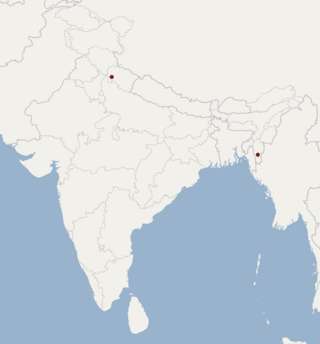
Elasmucha grisea, common name parent bug, is a species of shield bugs or stink bugs belonging to the family Acanthosomatidae. The term parent bugs includes also the other species of the genus Elasmucha and some species of the family Acanthosomatidae.

Magnaporthe grisea, also known as rice blast fungus, rice rotten neck, rice seedling blight, blast of rice, oval leaf spot of graminea, pitting disease, ryegrass blast, Johnson spot, neck blast, wheat blast and Imochi (稲熱), is a plant-pathogenic fungus and model organism that causes a serious disease affecting rice. It is now known that M. grisea consists of a cryptic species complex containing at least two biological species that have clear genetic differences and do not interbreed. Complex members isolated from Digitaria have been more narrowly defined as M. grisea. The remaining members of the complex isolated from rice and a variety of other hosts have been renamed Magnaporthe oryzae, within the same M. grisea complex. Confusion on which of these two names to use for the rice blast pathogen remains, as both are now used by different authors.
Prunus grisea is a species of plant in the family Rosaceae. It is found in Malaysia, the Philippines, Singapore, and Taiwan.

Peters's tube-nosed bat is a species of vesper bat in the family Vespertilionidae, found in the Indian Subcontinent, mainly in the Western Himalayas. They have tube-shaped nostrils which assist them with their feeding. They are brown with white-yellow and underparts and have specks of orange around their neck. While they are roosting, their fur, which seems to appear as a dead plant, camouflages them from predators. They are 3.3-6.0 cm in length and have round heads, large eyes and soft fur. This bat is found in India. They are endangered due to clearing of the rain forests in which they live in and are not protected by the World Conservation Union. They feed on rain forest fruit and blossoms.

Verdamicin is an aminoglycoside antibiotic produced by Micromonospora grisea.

Acalolepta is a genus of flat-faced longhorns beetle belonging to the family Cerambycidae, subfamily Lamiinae. Its members are found in the Indomalayan realm.

Nicholas José Talbot FRS FRSB is Group Leader and Executive Director at The Sainsbury Laboratory in Norwich.
Acalolepta griseofasciata is a species of beetle in the family Cerambycidae. It was described by Stephan von Breuning in 1935, originally under the genus Dihammus. It is known from Papua New Guinea, Vanuatu, and the Solomon Islands.
Acalolepta itzingeri is a species of beetle in the family Cerambycidae. It was described by Stephan von Breuning in 1935.
Acalolepta sikkimensis is a species of beetle in the family Cerambycidae. It was described by Stephan von Breuning in 1935.
Acalolepta magnetica is a species of beetle in the family Cerambycidae. It was described by Francis Polkinghorne Pascoe in 1866, originally under the genus Monochamus. It is known from Micronesia, Moluccas and Indonesia.
Acalolepta permutans is a species of beetle in the family Cerambycidae. It was described by Francis Polkinghorne Pascoe in 1857, originally under the genus Monohammus. It is known from Japan, Vietnam, Taiwan, and China. It feeds on Albizia julibrissin.
Acalolepta montana is a species of beetle in the family Cerambycidae. It was described by Per Olof Christopher Aurivillius in 1916. It is known from Sulawesi.
Acalolepta flocculata is a species of beetle in the family Cerambycidae. It was described by Gressitt in 1935. It is known from Taiwan and China.
Acalolepta antenor is a species of beetle in the family Cerambycidae. It was described by Newman in 1842. The typical form is known from the Philippines, but numerous subspecies are widespread in Indonesia, Moluccas, Micronesia, New Guinea, Australia, Solomon Islands and Samoa.

Acalolepta fraudatrix is a species of beetle in the family Cerambycidae. It was described by Henry Walter Bates in 1873. It is known from Korea, Japan, China, and Russia.
Acalolepta mixta is a species of beetle in the family Cerambycidae. It was described by Frederick William Hope in 1841, originally under the genus Monohammus. It is known from Australia, and was introduced to the Solomon Islands, Indonesia, Singapore and Vietnam. It feeds on Theobroma cacao, Adansonia digitata, Mangifera indica, Excoecaria agallocha, and Moringa oleifera.
Acalolepta rusticatrix is a species of beetle in the family Cerambycidae. It was described by Johan Christian Fabricius in 1801, originally under the genus Lamia. It is known from Myanmar, India, the Philippines, Malaysia, Sumatra, Sri Lanka, Java, Taiwan, Indonesia, Sulawesi, and Vietnam.
Acalolepta sejuncta is a species of beetle in the family Cerambycidae. It was described by Henry Walter Bates in 1873. It is known from Japan.






